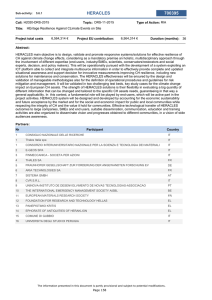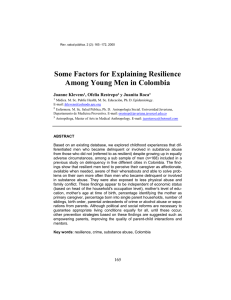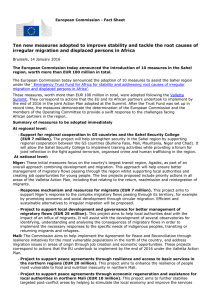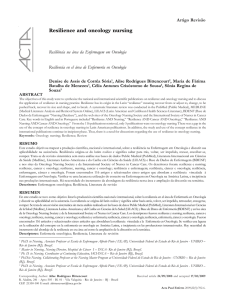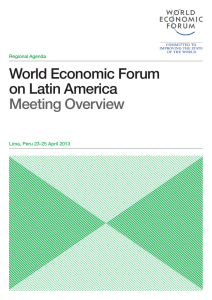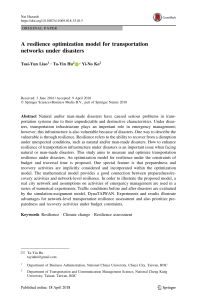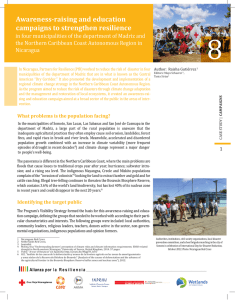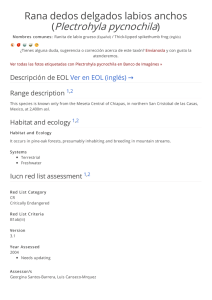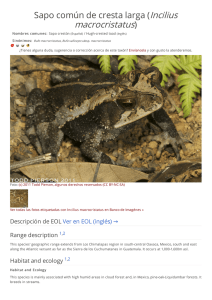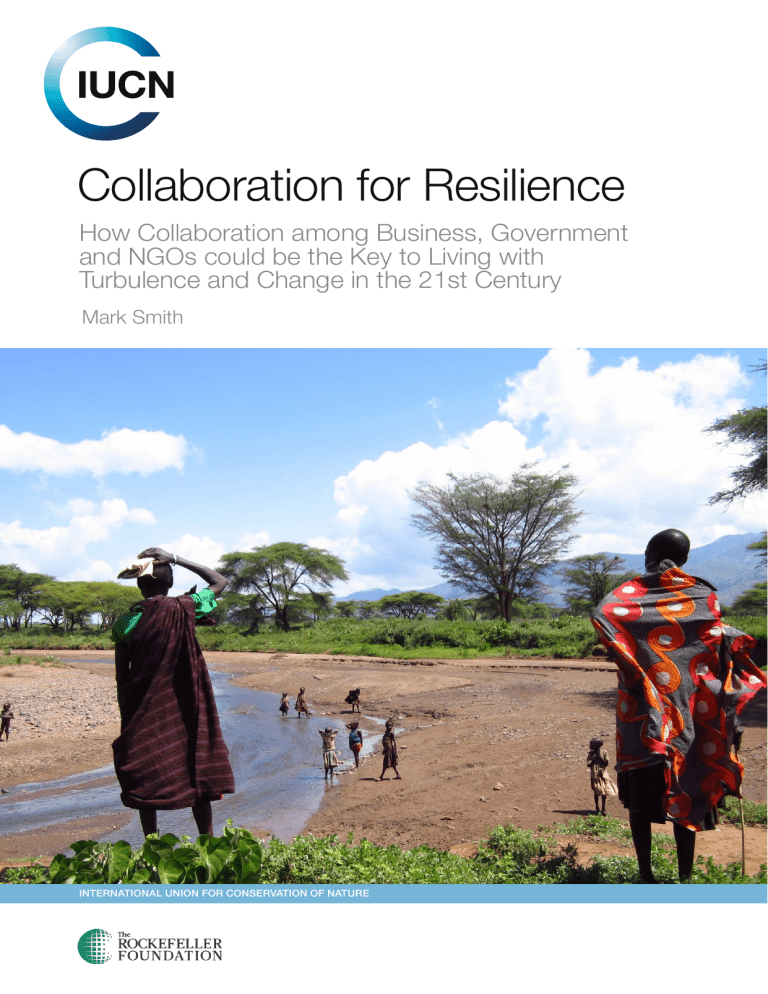
Collaboration for Resilience How Collaboration among Business, Government and NGOs could be the Key to Living with Turbulence and Change in the 21st Century Mark Smith International Union for Conservation of Nature IUCN is a membership Union uniquely composed of both government and civil society organisations. It provides public, private and non-governmental organisations with the knowledge and tools that enable human progress, economic development and nature conservation to take place together. Created in 1948, IUCN is now the world’s largest and most diverse environmental network, harnessing the knowledge, resources and reach of more than 1,300 Member organisations and some 16,000 experts. It is a leading provider of conservation data, assessments and analysis. Its broad membership enables IUCN to fill the role of incubator and trusted repository of best practices, tools and international standards. IUCN provides a neutral space in which diverse stakeholders including governments, NGOs, scientists, businesses, local communities, indigenous peoples organisations and others can work together to forge and implement solutions to environmental challenges and achieve sustainable development. Working with many partners and supporters, IUCN implements a large and diverse portfolio of conservation projects worldwide. Combining the latest science with the traditional knowledge of local communities, these projects work to reverse habitat loss, restore ecosystems and improve people’s well-being. www.iucn.org Collaboration for Resilience How Collaboration among Business, Government and NGOs could be the Key to Living with Turbulence and Change in the 21st Century Mark Smith - Director IUCN Global Water Programme The designation of geographical entities in this book, and the presentation of the material, do not imply the expression of any opinion whatsoever on the part of IUCN or the Rockefeller Foundation concerning the legal status of any country, territory, or area, or of its authorities, or concerning the delimitation of its frontiers or boundaries. The views expressed in this publication do not necessarily reflect those of IUCN or the Rockefeller Foundation. Published by: IUCN, Gland, Switzerland, in collaboration with The Rockefeller Foundation Copyright: © 2016 International Union for Conservation of Nature and Natural Resources Reproduction of this publication for educational or other non-commercial purposes is authorized without prior written permission from the copyright holder provided the source is fully acknowledged. Reproduction of this publication for resale or other commercial purposes is prohibited without prior written permission of the copyright holder. Citation: Mark Smith (2016). Collaboration for Resilience: How Collaboration among Business, Government and NGOs could be the Key to Living with Turbulence and Change in the 21st Century. Gland, Switzerland: IUCN. 16pp. ISBN: 978-2-8317-1807-1 DOI: http://dx.doi.org/10.2305/IUCN.CH.2016.09.en Cover photo: Mogoth, Northern Uganda. Location of IUCN resilience project, aiming to reduce communities’ vulnerability to climate change, drought and changing water flows © IUCN / Claire Warmenbol Layout by: Imre Sebestyén, jr. / UNITgraphics.com Printed by: Artgraphic Cavin SA Available from: IUCN (International Union for Conservation of Nature) IUCN Global Water Programme Rue Mauverney 28 1196 Gland Switzerland Tel +41 22 999 0000 Fax +41 22 999 0002 [email protected] www.iucn.org/resources/publications Collaboration for Resilience Introduction: Converging Stresses in a Turbulent World Safe assumptions about the future are changing. According to one mapping of the future, global GDP will almost double between 2010 and 2030, from $50 to $95 trillion, and demand for primary energy will rise by 33%, food by 27% and water by 41% (Dobb et al., 2011). In another, humanity is pushing against ‘planetary boundaries’ and losing our ‘safe operating space’ as natural resource exploitation changes the Earth system (Rocktröm et al., 2009). In this view, we risk crossing (or have already crossed) thresholds – experienced as biodiversity loss, climate change or atmospheric, freshwater or marine pollution – that undercut human welfare. It does not necessarily follow that doubling of global economic output over time scales of a few decades is then off limits. However, it does follow that such growth will not take place if we use the same model of natural resource exploitation and biosphere depletion that has been the norm before now. Change is needed: deep change in the complex dynamics that link the economy, societies and the Earth and that shape the future. Thomas Homer-Dixon in wrote in The Upside of Down of five ‘tectonic stresses’ linking ecological, social and economic pressures (Homer-Dixon, 2006): • • • • • energy stress – especially from increasing scarcity of conventional oil economic stress – from more instability in the global economy and a widening gap between rich and poor demographic stress – from differences in population growth between rich and poor societies and from expansion of megacities environmental stress – from worsening damage to land, water, forests and fisheries, and climate stress – from changes in the composition of Earth’s atmosphere. These stresses are converging – in what Shell calls the ‘stress nexus’ (Böggemann and Both, 2014) – at the same time as the connectivity and speed of our societies is rising. This points to a world that is becoming riskier and, as Earth-system thresholds are approached and crossed, more prone to instability and surprise. We need change that will not only reshape dynamics among the economy, societies and planet Earth but also make us better at coping with turbulence. We need change that will increase resilience. Resilience means being able to survive, adapt and improve in the face of stress and change, to be able to withstand shocks, but reorganise and rebuild when necessary. The capacity to bounce back but ‘bounce forward’ to a better state if possible. Humanity has been hugely successful historically at responding to stresses, by innovating and inventing new technologies. Over time, however, unintended social and environmental consequences have accumulated because technologies alone offer only narrowly optimised solutions. Alongside the benefits that higher prosperity brings, we face as a result climate change, species extinctions, fisheries collapse or, in a more localised, technology-specific example, impoverishment downstream of hydropower dams. Technology is prone to accentuating the convergence of stresses, with their unknown impacts accumulating faster than knowledge of them and creating an ‘ingenuity gap’ that technology alone cannot bridge (Homer-Dixon, 2000). The technological pathways that we have relied on historically are not suited, by themselves, to the deeper changes needed for resilience to converging stresses. Increasing resilience demands transformations beyond technological change to include changes in governance, management regimes and the ways social and natural capital are built (or rebuilt) alongside economic value. To build resilience, we must learn how to change the complex systems linking the economy, societies and the Earth from within. Changing Systems from Within: Activating Change In The Solution Revolution, William Eggers and Paul MacMillan tell the stories of citizens, businesses, governments and philanthropists who work together to find solutions to difficult-to-crack problems (Eggers and MacMillan, 2013). For example, they profile Unilever in India, which worked with NGOs, banks and schools to open a new market of more than 600 million people for soaps and cleaning products, by supporting local female entrepreneurs to create a vast but local distribution and sales network. The company benefited, but at the same time as improving public health and sanitation and lifting women and their families from poverty with microloans and jobs. They explain how networks of NGOs, companies and government agencies have come together at global scale to monitor and disrupt human trafficking, or how social entrepreneurs at local scales are setting up restaurants and cafés with the goal of creating employment opportunities for socially excluded and disadvantaged young people. How Collaboration among Business, Government and NGOs could be the Key to Living with Turbulence and Change in the 21st Century 3 Collaboration for Resilience These collaborations combine the capacities, talents, reach and resources of the public and private sectors and civil society to activate change. They choose collaboration because of growing recognition that their sectors have overlapping interests and there are mutual gains to made. There may, similarly, be mutual gains to be found in an agenda for building resilience (Case 1). Case 1 – Urban Resilience, New York City (The City of New York, 2013) The New York Metropolitan Area is home to almost 20 million people and a large number of small and medium-sized businesses as well as multinational corporations. Sitting at the hub of the global finance and trading systems, New York’s interconnectedness is deep and global, creating vulnerabilities worldwide to disaster in New York City. Superstorm Sandy caused an estimated $50 billion in damage in 2012. The frequency of such extreme climate events – including flooding, heat waves and tornadoes – is projected to increase because of climate change. 1-in-100 year flood hazards are projected to occur at a frequency of 1-in-15 years for example. The resilience of New York City is a concern for citizens and public agencies, but also for business, whether operating locally or globally. In the aftermath of Superstorm Sandy, the City of New York worked with Federal and State agencies and consulted with community organisations and businesses to produce a resilience plan for the city. The plan prioritises actions needed to build resilience in vulnerable parts of the city, including coastal protection actions, amendments to zoning and building codes, retrofitting of buildings for wind and flood resilience, insurance initiatives and changes to infrastructure and organisation for healthcare, telecommunications, electrical utilities, water and wastewater and transportation. Assessments carried out by engineering companies have identified how to build the resilience of critical infrastructure such as the electrical grid. They identify options for making the grid more robust, using technologies for flood-proofing but also programmes for reducing energy demand by voluntary means and eventually advanced energy management systems. At the same time, New York City’s plans call for a focus on strengthening individuals and groups able to organise and mobilise response at local level, to help get people back to their homes quickly after disruptive events. After the shock of Superstorm Sandy, New York City has begun making changes needed to strengthen resilience by combining citizen organization with new government policies and regulations that create demand for services from companies that can help. New York’s experience is representative of a nascent interest among governments, the private sector and civil society in aligning around a recognition that with rising interconnectivity and stresses, risks are becoming more tightly coupled, locally and globally. Each sector needs effective strategies for building resilience and hence achieving their goals in a more turbulent world. Businesses are turning their attention to resilience to remain relevant by helping meet new customer needs for more resilience, as well as in recognition of a need to build and protect long-term shareholder value under converging stresses. Governments aim to find resilient pathways to creating prosperity in a riskier world, while civil society is aiming to use its networks and knowledge to champion solutions for resilience based in social justice and a reawakening to benefits from nature conservation. Just as in the stories told in The Solution Revolution, there may be mutual gains to be made from collaboration on resilience among sectors. To succeed, collaboration will have to be effective in activating changes from within the complex system of the economy, society and nature that are needed to strengthen resilience. Lessons in activating change from within systems can be drawn from other settings. Based on the Nobel prizewinning work of Elinor Ostrom, adaptive governance of natural resources, for example, is more effective in achieving beneficial change where decentralized, self-organising institutions are rich in information and empowered to make decisions on collective action through dialogue and deliberation (Dietz, Ostrom and Stern, 2003). In Leading Change, John Kotter set out an 8-step process for successfully managing change in organizations. These build from creating a sense of urgency and convening a coalition of champions through to empowering people to take action and embedding change in new cultures (Kotter, 1996). In either setting, re-orienting and reshaping a system from within is more successful where efforts are made to help people relearn expectations and norms, supported by data, communications, empowerment and learning-by-doing. While collaboration on resilience across sectors is made attractive by the potential for mutual gains, it needs therefore to do more. In addition to mutual gains, cross-sector collaboration should have the objective of bringing together the elements needed to activate change that builds resilience more effectively and more rapidly. 4 How Collaboration among Business, Government and NGOs could be the Key to Living with Turbulence and Change in the 21st Century Collaboration for Resilience Collaboration to Activate Innovation for Resilience Interest in and commitment to collaboration among business, the public sector and civil society has in part grown out of experience of conflicts between communities and companies. Public and NGO pressure in natural resource sectors (especially energy, mining, forestry and agriculture) for example has undermined social ‘licence to operate’, increased costs and, ultimately, forced companies out of particular markets. Companies face costs therefore where they shrink from societal change. Governments can encourage companies to respond constructively, invest in change and avoid social conflict by putting in place rules to create sanctions and incentives. Tightening of standards and regulations has led many companies to learn that the better path, instead of battling protestors in the courts, markets or even physically, is to work with stakeholders to avoid or mitigate environmental and social impacts of business operations. They work collaboratively with civil society and governments to ‘co-create’ solutions (Case 2). Companies have learned that possessing the skills needed for stakeholder engagement and co-creativity brings competitive advantage (Higginson and Vredenburg, 2010). Case 2 – Marine Stewardship Council (Henderson and Albani, 2013) The global seafood industry was under intense public and consumer pressure in the 1990s because unsustainable fishing practices were blamed for severe degradation of marine ecosystems. With the collapse of the Newfoundland cod fishery in the early 1990s, there were calls for urgent action to halt the overexploitation of major fisheries around the world, to protect not only the marine environment, but also fishing livelihoods. Unilever, the largest fish retailer at the time, and the World Wide Fund for Nature (WWF) joined forces to respond. They jointly led and financed a two-year process to build consensus around the design for a sustainability standard for marine fisheries and to launch an organisation to develop and operate a certification scheme. With effective leadership, resistance to a standard from many fishing companies and some governments was overcome, and in 1999 the Marine Stewardship Council (MSC) was launched as an independent organisation. Almost 15 years later, 10% of global marine fish harvest is certified through MSC, with a value of $3 billion annually. The MSC operates as a non-profit, under governance that brings together civil society and business, including through a Stakeholder Advisory Council comprising representatives from NGOs, academia, fishing companies and trawling industry associations. The MSC is contributing to pulling many fisheries back from the threat of collapse, or at least slowing the approach. Marco Albani and Kimberley Henderson surveyed business, government and NGO leaders to distil lessons from both failures and achievements in collaborations (Albani and Henderson, 2014). They identified seven essential principles of success: 1. Identify clear reasons to collaborate – Commitment will be weak if the motivation for partnership is simply not to be left out. Participants need to be able to pinpoint strong and ambitious motivations that make sense for all parties, with potential rewards that are big enough to excite people and justify the effort involved. 2. Identify a ‘fairy godmother’ – The natural temptation is to come in late to a collaboration as first-movers take the biggest risks. If nobody starts, however, nothing will happen. It helps then if a high-performing institution shows the way – acting as the ‘fairy godmother’ – through courageous leadership, by taking on the early risk and by using its credibility to help build trust. 3. Set simple, credible goals – Collaborations will stall when partners have different agendas. Collaboration works best when it is anchored by an exciting, big idea that sets the aspirational goal that everyone agrees on. 4. Get professional help – Even with the best intentions, collaborations are easily beset by conflicts and biases and clashes of organisational cultures, especially early on. An independent, third-party facilitator can keep the discussions going until the partners find common ground. How Collaboration among Business, Government and NGOs could be the Key to Living with Turbulence and Change in the 21st Century 5 Collaboration for Resilience 5. Dedicate good people to the cause – Cross-sector collaborations are inherently ‘business unusual’. Partners need to contribute staff with the talents, skills and creativity to resist business as usual and to energise the partnership like a start-up. They need active backing from senior leadership. 6. Be flexible in defining success – Collaboration might not lead to the precise results intended, but still succeed in activating valuable, positive change. Success may therefore come from unexpected directions, which partners should be ready to embrace and build on. 7. Prepare to let go – No collaboration should be kept alive beyond its useful lifetime. As they progress, partners should plan for a process of either winding down the partnership or spinning it off into an independent entity. Several of these principles are reflected, at local scale, in the experience of innovation for resilience in Wallowa County, Oregon. Local government, businesses and citizens came together with the goal of rescuing the community from terminal decline caused by ecosystem collapse (Case 3). Case 3 – Timber Industry Reorganisation and Transformation, Wallowa County, Oregon, USA (Jones and Cristoffersen, 2014) Listing of Chinook salmon under the Endangered Species Act in north-east Oregon led to near cessation of timber harvesting in the Wallowa-Whitman National Forest (WWNF) in 1992. Sawmills closed and WWNF revenue declined by 98%. In addition to jobs lost in the timber industry, staffing of the WWNF was cut by 50%, leading to removal of the forest management regime and decline in forest health. Pest infestation and high-intensity fires caused extensive forest die off. To lead reorganisation and innovation for resilience, local government and local citizens formed Wallowa Resources, a non-profit organisation, in 1996. The organisation implements programmes in watershed restoration and research and education on community stewardship, while running Community Solutions Inc., a for-profit company to provide capital and business development services for local forest-based companies. Partnerships among Wallowa Resources and local businesses restored salmon and trout habitat and 80,000 ha of watershed. They installed microhydro and biomass power generators and, critically for renewal of the local economy, succeeded in restarting commercial timber operations through collaborative agreements among the State, communities and local business. While Wallowa Resources played ‘fairy godmother’ in Wallowa County, the partners were not spared from pitfalls in collaboration for resilience. Their success is locked-in to the local scale because of lack of leadership and courage at higher levels. The results achieved remain modest relative to the potential of the forest resources available because policy and law at higher levels, as well as environmental NGOs, are trapped in a use versus no-use debate that works against large-scale reorganisation and is a disincentive to corporate investment (Jones and Cristoffersen, 2014). Collaboration and empowering people to take action were key to unlocking the processes of change at local scale, but their absence at higher scales may be blocking the ‘bounce forward’ needed for the region’s forest-based economy. Cross-sector collaborations that succeed in activating change for resilience are not a simple undertaking. They need to be innovative in finding ways to provoke and steer transformations beyond technological change to include changes in management regimes, governance and how social capital, natural capital and financial capital are developed and used. In trying to influence the workings of complex systems, collaborations must contend with uncertainties and unknowns and how nonlinearities affect outcomes for each sector. Collaboration on resilience is bound to be messy. To keep messiness manageable, all parties will need to work together to ensure that collaborations are set up and run well. In 2013, IUCN convened a small conference at the Bellagio Center, Italy, through a grant from the Rockefeller Foundation, on Developing Untapped Potential: Strengthening Resilience through Business, Public and Civil Society Collaboration. Participants came from government, NGOs and member companies of the Resilience Action Initiative (Böggemann and Both, 2014). They reflected on whether the potential for mutual gains across sectors provides the basis for a collaborative agenda on building resilience. They recognised that collaboration across sectors always presents challenges, but based on their own experiences in business, NGOs and government, they identified a set of pitfalls that collaboration for resilience will be especially sensitive to: 6 How Collaboration among Business, Government and NGOs could be the Key to Living with Turbulence and Change in the 21st Century Collaboration for Resilience • • • • • • • failure to define and agree on the problem to be tackled, and then to set clear goals launching into collaboration without investing in the necessary time and dialogue to fully diagnose the issues that lie behind vulnerabilities taking on the whole system because of failure to pick boundaries to the problem wisely unwitting lock-in to a narrow set of issues or limited range of scales because of lack of adaptiveness – so keeping things too simple at the beginning blocking progress later on isolation from existing action and failure to network and dovetail with existing collaborations trying to forge ahead without assistance from someone in the role of facilitator who can help to navigate the system ineffective leadership, lack of courage and credibility or no strong, high-level commitment from collaborating organisations Collaborators make an error if they are not working in the parts of the system that constrain (or, on the flip-side, make easier) reactions to the converging stresses that concern them. They will only make progress if they organise themselves in ways that help them to work among complex moving parts, but without getting lost. Collaboration to Build Resilience Activating change that makes complex interactions among society, economies and Earth systems more resilient needs reprioritisation in how people work together, organise and invest and how they value and manage the lifesupport systems that nature provides. It takes multiple strands of activities, but there is structure. There are ‘building blocks’ for resilience: • Diversity – in value chains and markets, but also in infrastructure and in nature. With diversity, an enterprise can switch to an alternate supply chain for example in case of disruption, while diverse teams foster innovation and creativity. Diversity in for example energy supply or transportation systems buffers populations and the broader economy against disruption. Diversity in nature is biodiversity, which helps to build, re-build and sustain the services from ecosystems – including crop pollination, water cycling, soil conservation and the stability of coasts and deltas – needed to reduce disaster risk and to cycle and supply the natural resources that underpin water, energy and food security. • Sustainable infrastructure and technologies – that are sustainable and robust, with wide tolerances and incorporating ecosystem functions, and that continue to operate in spite of climatic extremes or service outages. Transportation systems protected from flooding, for example, electrical grids with extra capacity and redundancy, or water treatment facilities that can be restarted quickly after major storms. Infrastructure and technologies likewise need to be sustainable, not undercutting the capacity to adapt and respond to stresses and shocks by contributing to social disruption or loss of system diversity or biodiversity. Options include ‘natural infrastructure’ using services from ecosystems, such as upland forests that store carbon and regulate river flows, wetlands and floodplains that store water and lower flooding, and mangroves, reefs and barrier islands that protect coastal communities and cities (Krchnak et al., 2011). • Distributed governance – with decentralised decision making at different levels connected through networks rather than a single, top-down centre of authority. Provided that responsibilities and boundaries of authority are clear and defined, responses to shocks and stresses can be identified independently and implemented rapidly at the most effective level, and coordinated and communicated through networks. Whether in a company or, for example, in a river basin trying to cope with water scarcity, decision making is then agile and the governance system itself can adapt to change. Decentralisation and participation in decision making generates the capacity to self-organise and dynamically reorganise, critical to resilience. • Learning – and access to information and knowledge. Companies, communities or public agencies can adjust their actions or redesign their operations more readily and in a more timely way if people are consistently learning and have the capacities to locate new data and information and then appropriately apply new knowledge. With application to scenario planning for example, they gain foresight capacity and an improved chance of detecting and reducing emerging vulnerabilities. Adaptiveness and innovation is strengthened further with scope to experiment, learn and adjust. How Collaboration among Business, Government and NGOs could be the Key to Living with Turbulence and Change in the 21st Century 7 Collaboration for Resilience Collaboration can contribute to each of these building blocks. To begin with, collaboration enhances diversity. It brings a diversity of players together to work on problem solving and change. Working collectively they bring variation in resources, including financial, social and natural capital. Business can provide managerial expertise and financing streams, while civil society can mobilise communities quickly with grassroots knowledge. From collaboration, a wider range of options and ideas may emerge for responding to stresses and disruptions, including options that work at local level, closer to impacts, that may be alternatives to or coordinated with actions at higher scales (Case 4). Case 4 – Restoring Resilience in Shinyanga Region, Tanzania (Barrow, 2014) From the 1950s to the 1980s, woodlands were cleared in semi-arid Shinyanga Region, north-west Tanzania to eradicate tsetse fly and to open land for agricultural cash cropping. By 1985, the region was declared the ‘desert of Tanzania’ by President Nyere, with the agro-pastoralist Sukuma people in the region vulnerable to water and fuelwood shortages and suffering declining productivity because of soil erosion and scarcity of dry season forage for livestock. Reversing its previous top-down policy, government introduced a landscape restoration programme that resurrected traditional local management institutions. Working with local people, district government and NGOs, these mobilised local knowledge on woodland management through participatory planning to restore ngitili, or enclosed woodland reserves. By 2004, approximately 300,000 ha of ngitili had been restored. The multiplicity of goods (fuel, building timber, fruits, fodder, medicines) from the ngitili spread the risk of cash crop failure, and better watershed condition improved water availability using natural infrastructure. Communities reorganised and rebuilt to become more food, energy and water secure. With infrastructure and technologies, governments, civil society and business may have more success by working together to ensure that the options they select are robust. They can have a deeper understanding through collaboration of the breadth of stresses that need to be taken into account and their impacts at different scales. Jointly, they may identify packages of infrastructure and technologies, including their operations and use of ecosystems as natural infrastructure, that avoid social disruption or environmental impacts and contribute to adaptive capacity (Case 5). Case 5 – Urban Drought Resilience, Gold Coast, Australia (Davis and Farrelly, 2009) Between the mid-1990s and 2010, Australia contended with the ‘Millennium Drought’, said to be driest period since European settlement. Although Australia is a country used to living with periodic water scarcity, this led Australians and Australian governments to rethink the way water is used and managed. There is broad recognition that significant components of the Australian economy are vulnerable to drought, certainly including agriculture, but also the main urban centres. With climate change in mind, major steps are underway – including many that are highly contested – to change how water allocations are prioritised, introduce much greater flexibility in responding to drought, and to cut water demand. Cities are leading the way by applying ‘Water Sensitive Urban Design’ to reducing vulnerabilities to drought. The City of Gold Coast in South-east Queensland, has relied on the Hinze Dam for its primary source of drinking water, but with population in the region projected to grow from 400,000 to 1.1 million by 2050, climate-resilient alternatives are needed. As part of its response, the City Council called for a ‘Waterfutures Master Plan’ for a new housing development at Coomera Waters in the mid-2000s. The challenge was to transform conventional urban water systems in Coomera Waters. The Council put together a project team comprising a mix of Council staff and seconded personnel from industry who worked together to build participation by stakeholders in the process, including housing developers, construction trades, resident associations, environmental groups and other parts of government. The final plan integrated rainwater harvesting, dual water supply to households (potable and recycled grey water), ‘smart’ stormwater management and sewerage, natural infrastructure (restored and artificial wetlands), demand management and community education. Serving 150,000 people over a 7000 ha site, the plan is projected to reduce use of potable water by 84%. 8 How Collaboration among Business, Government and NGOs could be the Key to Living with Turbulence and Change in the 21st Century Collaboration for Resilience Participants in the project identified collaboration among both professionals and stakeholders as key to overcoming regulatory and approval barriers and to learning that led Council staff to become catalysts for change in their organisation. The project created the space needed for a cross-disciplinary and inter-institutional collaborative team to innovate and experiment, not only with engineering, but also social and regulatory change. Coomera Waters will as a result be less vulnerable to drought than older suburbs reliant on the dam. Collaboration among governments, civil society and business in distributed governance increases participation and participation in networks. Collaboration hence opens new ways of self-organising and reorganising, which help people to not only respond to change but also to promote and experiment with change. Those closest to the impacts of stresses and disruptions can then shape and define solutions to vulnerabilities. They can also come to consensus – through multi-stakeholder dialogue and negotiations and through partnerships – on who is responsible for different types of decisions and at which levels, while using networks to communicate and coordinate (Case 6). Finally, collaboration fosters learning. Working jointly, business, governments and civil society can develop new knowledge networks that provide more channels for learning and for acquiring and sharing data and information. They have more opportunities to experiment, learn collectively from success and failure and to then adjust or reorganise accordingly. Through collaboration and knowledge networks they can put in place feedback loops that enable faster responsiveness to new information that is then applied more effectively (Case 6). Case 6 – Developing Untapped Potential in the Tacaná Watersheds (Barchiesi, Welling & Cordoba, 2014) In the region lying under the Tacaná volcano, between the watersheds of the Coatán River, which rises in Guatemala before flowing into Mexican territory, and the Suchiate River, forming most of the frontier between the two countries, a project started in 2003 within the framework of the IUCN Water and Nature Initiative (WANI). The main goal was to reverse environmental degradation of the watersheds, which are of great strategic importance for both countries since they supply water to a large number of residents in the cities located in the lower areas and the main source of irrigation for agricultural and livestock purposes. By restoring them the risk of devastating floods could be significantly reduced. Before the intervention, a complex land tenure system was causing delays in the transfer of rights from municipalities to private citizens and indigenous people were being marginalised. Lack of technical support and exchange across multiple levels of governance was leading to difficulties in translating knowledge of hydrological risk into action. With the support from the Tacaná Project, communities built microwatershed councils to lead watershed restoration and development that met their priorities. Generation of local knowledge brought better disaster preparedness. Empowerment of community-owned institutions started making watersheds more secure and livelihoods less vulnerable to climate change. The main form of collaboration for activating innovation while building adaptive capacity across the private, public and civil sectors in Tacaná was the formation of microwatershed councils. In particular, the process for setting up microwatershed plans helped to overcome barriers to a distributed governance system and to stakeholders sharing and applying their knowledge through networks. To further strengthen learning, Guidelines for the Development of Microwatershed Management Plans have been promoted at the national level in Guatemala for nearby communities and other microwatersheds to promote replication of the actions implemented in Tacaná. There are few direct examples yet available of collaboration among business, the public sector and civil society with explicit goals of activating change to build resilience at significant scale. The challenge is for the sectors to combine forces to address the multi-faceted qualities of resilience. If they share ambitions for resilience, their strategy should be to create packages of actions in which they are allies in tackling the building blocks of resilience. By working together, they can use their respective capacities and strengths to unlock the synergies among their respective contributions to each of diversity, infrastructure and technologies, distributed governance and learning. By working across these building blocks, they can achieve transformations beyond technological change by bringing changes in governance, investment, technologies, social capital and ecosystem restoration and conservation into alignment with resilience. How Collaboration among Business, Government and NGOs could be the Key to Living with Turbulence and Change in the 21st Century 9 Collaboration for Resilience Collaborative Agenda for Resilience Those gathered at the Bellagio Centre for the conference Developing Untapped Potential: Strengthening Resilience through Business, Public and Civil Society Collaboration did not come away with a definitive plan for how collaboration will ‘change the game’ of building resilience. That was neither expected nor possible. They did, in keeping with the messiness of change in complex systems, come away with a still fuzzy picture of what might be possible. Dialogue over the course of the conference showed how there is still a need to make better translations of resilience concepts, which tend to the abstract, into understanding of practical needs. Groups from business, government and civil society will need to work further together to identify clear and compelling goals for resilience that they can share and for which collaboration will bring mutual gains. The groundwork for a future collaborative agenda on resilience is, however, being put into place. The elements of good strategy are becoming clearer. In building their collaboration, business, government and civil society will be wise to apply the seven principles for successful collaboration and they will need to plan and structure joint action to address the building blocks of resilience – diversity, sustainable infrastructure and technologies, distributed governance and learning. By taking action within these building blocks and creating packages that link them together, the sectors will be able to work together both practically and systemically. With this basic framework for strategy in mind, but without yet a readiness to articulate shared goals and mutual gains, participants in Bellagio made four recommendations to help clear a pathway to a collaborative agenda on resilience: Recommendation 1: Intensify learning across sectors and promote leadership on resilience A platform to regularly convene through leaders and practitioners in continuing dialogue could take the form of a ‘resilience garage’. Convening would take place approximately annually in small meetings designed for high-quality exchange of knowledge and learning, with invited participation by a mix of representatives from the private and public sectors and civil society. Participation would include both a core convening group able to attend consistently and others invited for individual meetings. The guiding aim of the resilience garage would be to catalyse a faster and more effective translation of resilience theory into practice, by deepening understanding of practical and strategic needs beyond abstract concepts of resilience and hence moving practice and theory along in unison. Dialogue would be structured to assess specific projects and cases from companies, non-profits or governments, or their collaborations. Under the ‘garage’ concept, participants would use a joint diagnostic and discovery approach to provide a ‘tune-up’ for the projects, which could then go forward and test the recommendations. Results and lessons from the resilience garage would be disseminated through sectoral networks by participants as a means of championing the creation of a rigorous, high quality resilience practice. Recommendation 2: Develop better metrics and data for assessing and monitoring resilience The case for action on resilience building will be stronger if better data and better metrics are available to make resilience a tangible quality of for example cities or countries. Accepted methods for assessing resilience performance will make it easier for governments, companies or civil society partners to gather data that they can use to prioritise actions needed to strengthen resilience and to relate resilience to risk profiles. Resilience metrics will also make it easier to communicate – to decision makers or the general public – about resilience in ways that are concrete and tangible rather than abstract. Development of a ‘resilience index’ would help to mobilise action on methodological development, data collection and analysis and communication on resilience. The resilience index would be multidimensional and applied for example to cities, river basins, sub-national regions or countries, enabling comparative assessment of resilience, prioritisation of needs and risks. Recommendation 3: Experiment with building resilience in an incubator network Suitable, existing field-based projects offer the chance to experiment with building resilience in practice. Many organisations (whether non-profits such as IUCN or The Energy and Resources Institute (TERI) or businesses such as Yara or Shell) run site-based projects in all corners of the world, working for example on poverty reduction, river basin management, landscape restoration or support for agricultural entrepreneurship. Where most effective, these integrate aspects of learning, participatory governance, natural diversity and new economic opportunities. In many instances these projects cross scales, linking local to national levels, and they incorporate or provide opportunities 10 How Collaboration among Business, Government and NGOs could be the Key to Living with Turbulence and Change in the 21st Century Collaboration for Resilience for collaborative partnerships among civil society, business and the public sector. Collectively, such projects provide an incubator network – or Joint Action Network – for experimenting with resilience and especially with practical approaches to assessing resilience and testing interventions that build resilience. In parallel, the ‘Resilience Project’, led by EcoTrust1, is developing an online platform for exchange of learning and effective practice in resilience building. The aim is to create a ‘resilience emporium’ that brings together problem owners and solutions providers to directly exchange (and adapt) proven good practice and tools for resilience, and hence to catalyse and accelerate scaling up of solutions. The Joint Action Network would proactively develop collaborative, field-based experimentation with resilience, while feeding results into the ‘resilience emporium’ as part of strategies for scaling up. The Network would thus aim to develop and apply an ‘experiment-exchange-elevate’ model to action on resilience across large numbers of networked, worldwide sites with cross-sector collaboration. Recommendation 4: Start to actively broker partnerships and financing for resilience projects Accelerating collaboration on resilience will need bankable projects. A Resilience Project Development Agency would proactively develop cross-sector partnerships to support the design and financing of place-based projects for resilience building. The Agency would specialise in application of resilience principles and practice to create effective projects that are investment-ready. Such projects would work on resilience of cities, countries or for example regional development (e.g. growth corridors). The Agency approach would mobilise and broker partnerships needed for implementation, but also financing, for example by creating windows for funding that combine project grants and commercial financing in packages that integrate public goods and private sector opportunities. Conclusions Business, government and civil society are increasingly recognising that they must learn to operate in a more turbulent world. Each is contemplating a future where planetary boundaries, global interconnectedness and converging stresses will make disruptions and instabilities more common. Each faces the same fundamental challenge – that to be resilient they will need adaptive capacities to survive, reorganise, learn and improve within the complex systems in which they are embedded. Each sector therefore has a stake in innovation for resilience. Innovation for resilience needs to provoke and steer transformations beyond technological change to address social change that will reinforce adaptive capacities and safeguard benefits from nature’s services. There are echoes from organisational change in this challenge as well as research in the field of adaptive governance, as success is more apparent where change incorporates social processes that reshape norms. Collaboration, empowerment to take action and learning are key in organisational change and adaptive governance, but they are also an important means to leverage deeper change in how our societies and economies relate to Earth and the biosphere. More pragmatically, they are integral to action that reinforces the building blocks for resilience of diversity, sustainable infrastructure and technologies, distributed governance and learning. There are contributions to be made by each of the private and public sectors and civil society to the building blocks of resilience. However, knowledge of how to translate resilience concepts into either practical action or guiding strategies and policies is not well developed or widely shared. Lessons are emerging from a variety of cases in which change is demonstrated in response to vulnerabilities or collapse that combines elements of for example community action, innovation in programmes of local or national governments, or new services and leadership from business. These contributions reflect the interests of each sector in resilience, but also the potential of using collaboration among sectors to more effectively achieve results. Businesses, governments and civil society are just beginning to discover where there is mutual gain to be found from collaboration on resilience. A basic strategic framework for collaboration on resilience is emerging that combines well-founded principles for successful collaboration among business, government and civil society with a structured approach to action on the building blocks for resilience. Clearing a pathway to a collaborative resilience agenda will now depend on the sectors coming together to work on well-defined, practical problems that they can experiment with and learn from. Institutions and individuals who can act as brokers and facilitators to bring the sectors together are needed, not least to help build a common understanding of resilience, a common language that is shared by 1 http://www.ecotrust.org/ How Collaboration among Business, Government and NGOs could be the Key to Living with Turbulence and Change in the 21st Century 11 Collaboration for Resilience all sectors and an articulation of a shared vision and mission. They should work with leaders from the sectors to champion change needed for resilience and to promote learning from practical experiments with resilience that show results. Better metrics for resilience and diagnostics that will enable comparisons and monitoring of changes will help further. Finally, a collaborative resilience agenda should put in place networks that will share and elevate successful practice for activating change and scaling-up action on resilience, supported by partnerships that leverage the needed knowledge, resources and financing. 12 How Collaboration among Business, Government and NGOs could be the Key to Living with Turbulence and Change in the 21st Century Collaboration for Resilience References Albani M., Henderson K. 2014. Building resilience through teamwork: seven tips that make it work, pp. 79-84 in: Kupers R, ed., Turbulenc: A Corporate Perspective on Collaborating for Resilience. Amsterdam University Press, Amsterdam. Barchiesi S., Córdoba R. 2016. The Tacaná Watersheds, Developing Untapped Potential: Strengthening Resilience through Cross-Sectoral Collaboration, Gland, Switzerland. Barrow E. 2016. Retrofitting resilience to the Shinyanga landscape restoration. IUCN Commission on Ecosystem Management, Gland, Switzerland. Böggemann M., Both N. 2014. The Resilience Action Initiative: an introduction, pp. 23-34 in: Kupers R, ed., Turbulence: A Corporate Perspective on Collaborating for Resilience. Amsterdam University Press, Amsterdam. Davis C., Farrelly M. 2009. Demonstration Projects: Case Studies from South East Queensland, Australia. National Urban Water Governance Programme. Clayton, Victoria, Australia. (http://www.waterforliveability.org.au/wp-content/uploads/demo_proj_se_qld.pdf). Dietz T., Ostrom E., Stern P.C. 2003. The struggle to govern the commons. Science 302, 1907-1912. http://dx.doi.org/10.1126/science.1091015 Dobbs R., Oppenheim J., Thompson F., Brinkman M., Zornes M. 2011. Resource Revolution: Meeting the World’s Energy, Materials, Food and Water Needs. McKinsey Global Institute. (http://www.mckinsey.com/features /resource_revolution). Eggers W.D., MacMillan P. 2013. The Solution Revolution: How Business, Government and Social Enterprises are Teaming-Up to Solve Society’s Toughest Problems. Harvard Business Review Press, Boston. Henderson K., Albani M. 2013. Personal Communication Higginson N., Vredenburg. H. 2010. Collaborating for sustainability: strategic knowledge networks, natural resource management and regional development. International Journal of Sustainable Economy 2, 334-351. http://dx.doi.org/10.1504/IJSE.2010.033398 Homer-Dixon T. 2000. The Ingenuity Gap: Can We Solve the Problems of the Future? Vintage Canada, Toronto. Homer-Dixon T. 2006. The Upside of Down: Catastrophe, Creativity and the Renewal of Civilization. Random House, Toronto. Jones M., Christoffersen N. 2016. Restoration of forest systems and rural livelihoods in Wallowa County, Oregon: a partial resilience assessment of a work in progress. IUCN Commission on Ecosystem Management. Gland, Switzerland. Kotter J.P. 1996. Leading Change. Harvard Business School Press, Boston. Krchnak K., Smith D.M., Deutz A. 2011. Putting nature in the nexus: investing in natural infrastructure to advance water-energy-food security. Background paper for the stakeholder engagement process, Bonn2011 Conference: The Water, Energy and Food Security Nexus – Solutions for the Green Economy. (http://cmsdata.iucn.org/downloads/nexus_report.pdf) Rockström J. et al. 2009. A safe operating space for humanity. Nature 461, 472-475. http://dx.doi.org/10.1038/461472a How Collaboration among Business, Government and NGOs could be the Key to Living with Turbulence and Change in the 21st Century 13 International Union for Conservation of NAture WORLD HEADQUARTERs Rue Mauverney 28 1196 Gland, Suisse Tel +41 22 999 0000 Fax +41 22 999 0002 www.iucn.org How Collaboration among Business, Government and NGOs could be the Key to Living with Turbulence and Change in the 21st Century
